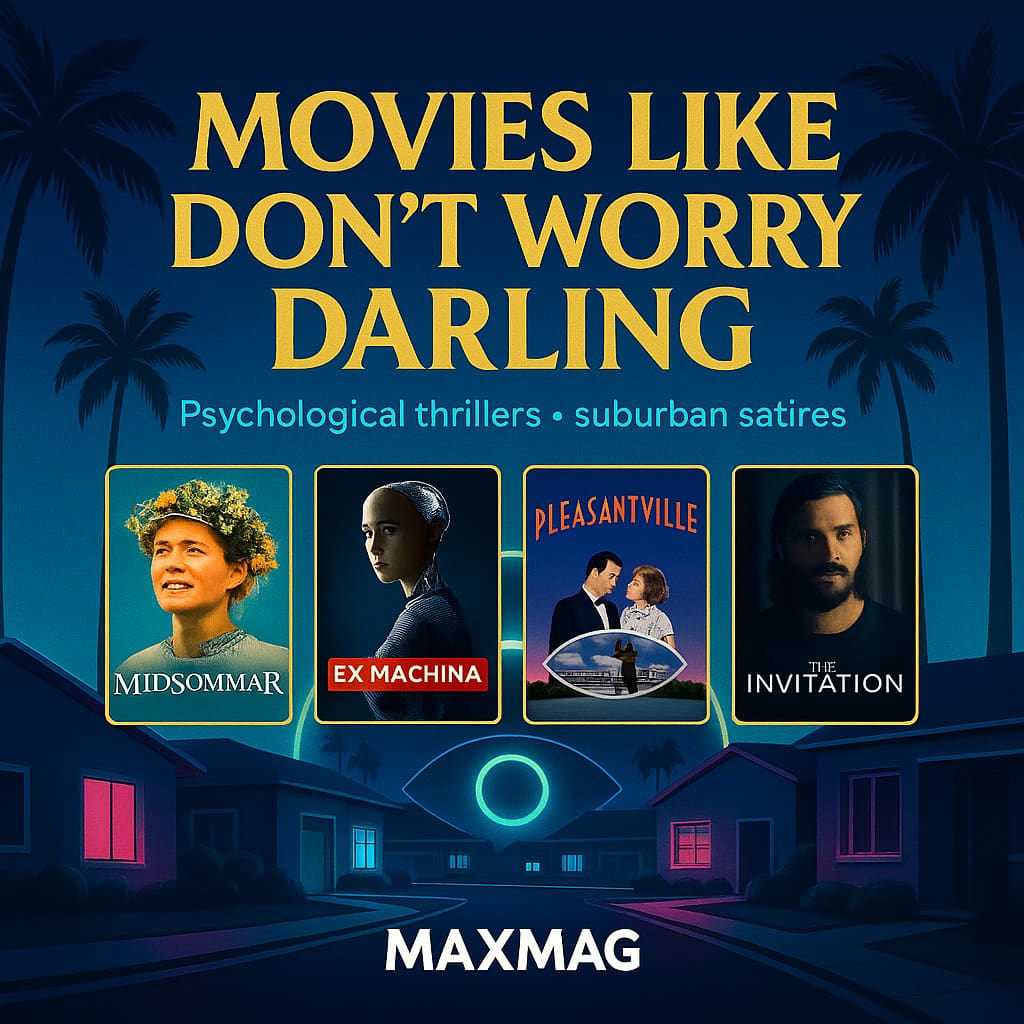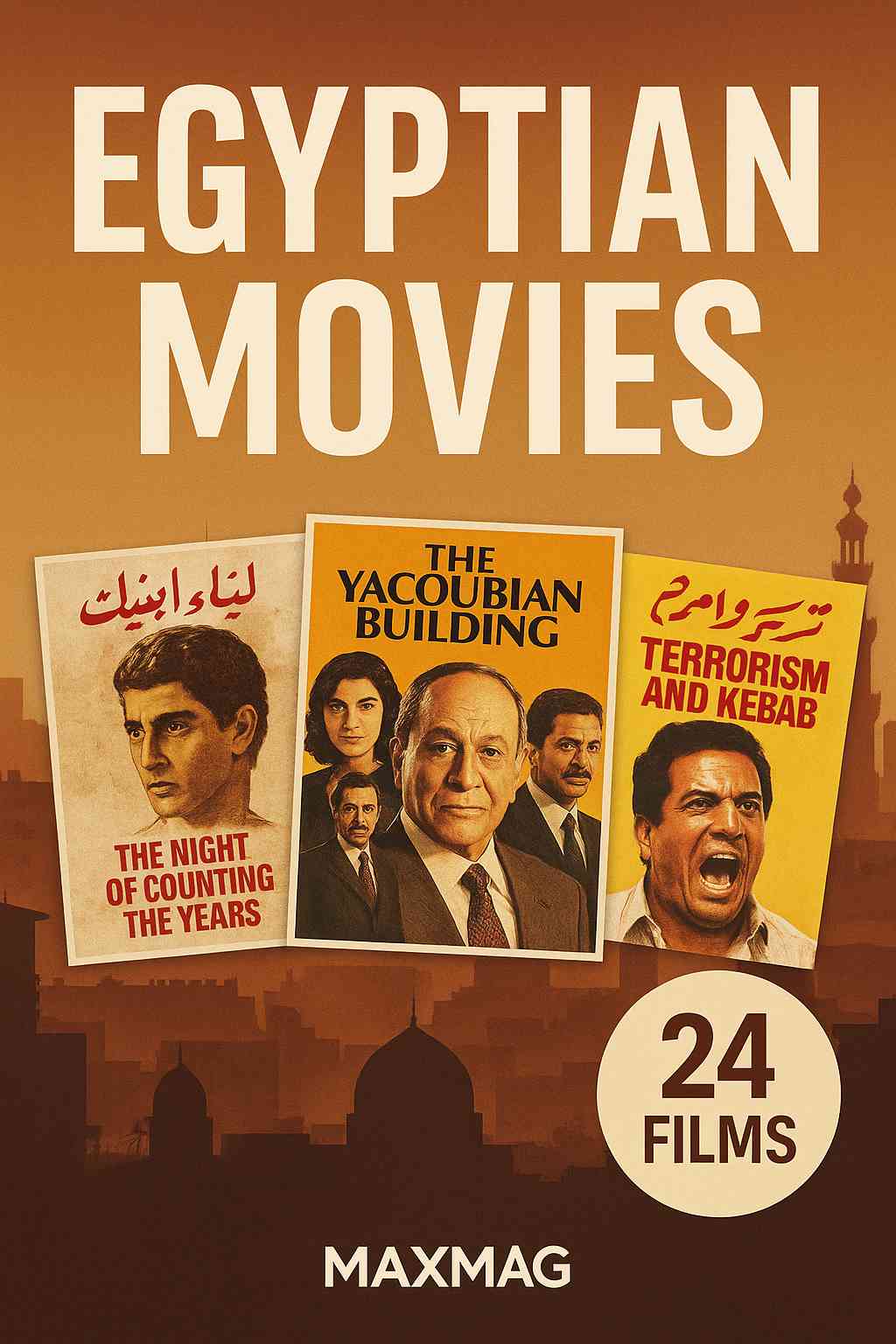
Fans looking for movies like Don’t Worry Darling will recognise a glossy psychological thriller that blends suburban satire with a creeping sense of control, where a seemingly perfect community hides a coercive design, escalating stakes hinge on a woman’s autonomy, a romance curdles into surveillance, and set‑piece “breaks” puncture the façade. This seed film’s genre is psychological thriller with social critique, its tone is sleek and ominous, its story engine is mystery‑box discovery, its stakes are identity and safety, its core relationship is a couple under strain, and its signature moments are ritualised parties, rules that never add up, and a courageously disobedient final sprint.
For this guide we define similarity with care: the films below track the same tonal temperature, run on investigation‑driven plotting, share themes of control, community complicity, and gaslighting, echo couple‑centric or outsider‑vs‑system character dynamics, and escalate personal stakes inside curated utopias. When you ask for movies like Don’t Worry Darling, we look for psychological thriller textures, reality‑tilting design, and social critique that keeps the entertainment factor high without losing bite.
Jump to: Top picks | Darker options | Lighthearted picks
How we scored similarity.We weighted five axes equally: tone (sleek, tense, or arch), narrative engine (investigation vs revelation), themes (control, complicity, performance), character dynamics (couples, outsiders, or captors), and stakes (identity, freedom, survival). We also ensured a thoughtful era & region mix so the list stays fresh while staying rigorously aligned with movies like Don’t Worry Darling.
Smart, socially sharp recommendations for movies like Don’t Worry Darling
1) The Stepford Wives (1975)
Few films prime the conversation around movies like Don’t Worry Darling better than this icy classic. A photographer moves to a perfect town where wives behave like mannequins and husbands meet in secret. The tone is slow‑burn, precise, and needling rather than sensational. The couple‑under‑pressure dynamic maps cleanly, with suspicion spreading between partners and friends. The setting’s HOA‑polished streets and cocktail hours weaponise domestic ritual. Emotional payoffs mirror the seed’s dread, replacing safety with a dawning, irreversible knowledge. If you loved the seed’s suburban satire and glossy noir sheen you’ll feel the same chill here. The closer lands with a hard, unforgettable snap that keeps echoing.
2) Get Out (2017)
Jordan Peele’s breakout sits adjacent to movies like Don’t Worry Darling in structure and sensation. A weekend visit spirals into a precision‑engineered trap dressed in manners and microaggressions. The tone is nervy, witty, and meticulously escalated. As with the seed, partner dynamics curdle as charm becomes gaslight and intimacy becomes leverage. The genteel exurban setting weaponises parties, auctions, and curated liberal décor. The emotional arc swaps safety for agency as truth forces a violent reckoning. Viewers drawn to the seed’s reality‑bending drama and feminist allegory will find this a razor‑edged mirror. The finale burns the mask off the room and never looks back.
3) The Truman Show (1998)
Peter Weir’s modern fable is a sunnier cousin to movies like Don’t Worry Darling, swapping menace for melancholy. Truman begins noticing glitches that suggest his pastel seaside life is an elaborate set. The tone is gently suspenseful with bursts of wonder and rueful comedy. Relationship fractures surface as partner and friends are enlisted to maintain the fiction. Its picture‑perfect setting turns architecture and product placement into bars of a cage. The payoff echoes the seed’s sprint toward self‑definition and open sky. If you loved the seed’s curated worldbuilding and escape velocity, this will glow for you. Its closing image remains one of cinema’s cleanest liberations.
4) Pleasantville (1998)
Gary Ross’s high‑concept gem sits near movies like Don’t Worry Darling on the spectrum of curated utopias. Two teens fall into a black‑and‑white sitcom world that bans mess, books, and complexity. The tone balances warmth, mischief, and a steady simmer of rebellion. Dynamics track desire vs conformity as relationships test the rules holding the town together. The retro‑suburban setting literalises control through monochrome moralism. Its emotional rise aligns with the seed’s turn from compliance to awakening. If you craved lighter textures around the same themes, this is your lighthearted lane. The final bloom of colour feels like a collective exhale.
5) Vivarium (2019)
This needle‑drop of dread rides close to movies like Don’t Worry Darling in its portrait of prefab hell. A starter‑home maze becomes a prison as an uncanny child arrives with impossible demands. The tone is bleak, clinical, and quietly absurd. Couple dynamics disintegrate under fatigue, surveillance, and weird domestic labour. The suburban development becomes a cosmic loop of cul‑de‑sacs and boxed lunches. Emotionally it matches the seed’s suffocation before breaking into grim catharsis. If you like the seed’s utopian dystopia played with icier detachment, try this. The ending locks its geometry with cruel elegance.
6) The Invitation (2015)
Karyn Kusama’s chamber piece syncs with movies like Don’t Worry Darling through ritual, rules, and social pressure. An ex is invited to a reunion dinner where apologies feel rehearsed and doors feel locked. The tone is slow‑boil domestic suspense with a final snap. Coupled histories and new partners collide, amplifying jealousy and persuasion. The mid‑century Hollywood Hills home becomes a stage set for controlled reveals. Its emotional payoff mirrors the seed’s hard turn from doubt to violent clarity. If you’re drawn to cult mystery under chandelier light, this delivers. The coda widens the horror with a single red signal.
7) Midsommar (2019)
Aster’s daylight nightmare shares DNA with movies like Don’t Worry Darling in aesthetics and power games. A grieving student joins her boyfriend on a remote festival that courts and consumes outsiders. The tone is pastoral, narcotic, and ritualistically violent. Relationship rot tracks as mismatched needs and gaslighting reshape boundaries. The white‑on‑white village, flowers, and runes weaponise design like advertising. Its emotional pivot crowns autonomy at a terrible, ecstatic cost. If the seed’s ceremony‑as‑control thrills you, this goes fuller and brighter. The last look is both coronation and abyss.
8) Ex Machina (2014)
Garland’s glass‑and‑concrete labyrinth sits near movies like Don’t Worry Darling on the axis of glamour and captivity. A coder visits a tech billionaire to test an AI in a bunker that markets itself as paradise. The tone is cool, cerebral, and tightening. Triangular dynamics mirror the seed’s triangle of desire, power, and surveillance. The minimalist compound turns architecture and glass into instruments of evaluation. Emotionally it aligns with the seed’s question of agency and self‑authorship. If you came for glossy rooms and weaponised charm, this scratches the itch. The final movement is an elegant, merciless exit.

9) The Lobster (2015)
Lanthimos flips the same themes under deadpan, brushing movies like Don’t Worry Darling with absurdist varnish. Singles must find partners in 45 days or become animals. The tone is clipped, chilling, and very funny in a straight face. Pairings and betrayals echo couple‑as‑compliance pressures from the seed. The coastal hotel and forest camps reduce romance to policy. Its emotional shape charts love forged in resistance and risk. If you enjoy suburban satire re‑cast as policy comedy, this is a tonic. The last choice lingers like a question you answer for yourself.
Shadow‑leaning picks that still track movies like Don’t Worry Darling
10) Coherence (2013)
This micro‑budget marvel channels the same dinner‑table tensions as movies like Don’t Worry Darling. Friends gather, a comet passes, and identity seems to multiply and split. The tone is talky, tense, and improvisational. Romantic and platonic ties rewire under suspicion, jealousy, and chance. A single house becomes a maze of doors and doubled selves. The emotional crest is panic giving way to a cold plan. If you liked the seed’s reality‑bending drama under soft lighting, file this high. The cut to black is a dare.
11) The Invisible Man (2020)
Whannell’s update sits within the orbit of movies like Don’t Worry Darling via control, optics, and escape. A woman leaves an abusive innovator whose presence persists as invisible violence. The tone is crisp, paranoid, and meticulously staged. Relationship dynamics chart coercion, disbelief, and hard‑won allyship. Bay‑view homes and labs turn surfaces into traps. The payoff aligns with the seed’s fist‑pumping reversal of power. If domestic suspense with gadget teeth appeals, start here. The final frame is a breath you can hear.
12) Rosemary’s Baby (1968)
Polanski’s landmark maps cleanly to the control‑and‑complicity lattice in movies like Don’t Worry Darling. A young couple moves into a storied apartment building and the world closes in. The tone is hushed, queasy, and intimate. Marital trust corrodes as ambition and community demands eclipse care. The Upper West Side setting cocoons danger in nursery décor and herbal tea. Its emotional vector replaces reassurance with terrible recognition. If you chase feminist allegory through velvet walls, this is foundational. The final gathering is a lullaby sung through teeth.
13) The Village (2004)
Shyamalan’s folk‑tinged mystery shares the seed’s interest in safety as performance, fitting movies like Don’t Worry Darling. A cloistered village warns of creatures in the woods while elders manage belief. The tone is autumnal, earnest, and quietly unnerving. Courtship, jealousy, and bravery push young lovers against doctrine. Handmade costumes and candlelit halls make control feel warm to the touch. The emotional turn reframes protection as imprisonment. If curated worlds and rulebooks thrill you, this is a key chapter. The last reveal re‑writes every lantern.
14) The Menu (2022)
Mark Mylod’s island satire feels like a culinary cousin to movies like Don’t Worry Darling. Diners discover courses are choreography for humiliation and reckoning. The tone is arch, punchy, and cruelly neat. Pairings, power plays, and betrayals mirror the seed’s social games. The restaurant’s choreography and plating style a theatre of obedience. Emotional release arrives through a humble, human reframe of desire. If glossy rules‑as‑prison thrill you, you’ll devour this. The last bite is an exit ticket wrapped in greaseproof paper.
Smoother, sly‑humour choices aligned with movies like Don’t Worry Darling
15) Swallow (2019)
This intimate portrait threads the same needle as movies like Don’t Worry Darling with hushed precision. A newlywed develops pica in a glass‑boxed home where choices are managed for her. The tone is delicate, restrained, and resolute. Spousal dynamics trace ownership disguised as care. Designer interiors and clean palettes stage a life curated for show. The emotional shape matches the seed’s careful build to self‑claim. If you want a softer register of the same pressures, start here. The final meeting redraws a future without asking permission.
16) The Truman Show (1998) — bonus pick
As a final nudge toward brighter textures within movies like Don’t Worry Darling, this remains essential. Truman senses the script and moves from politeness to defiance. The tone is humane, buoyant, and steadily daring. Friendships and marriage strain as truth punctures the set. The seaside town’s perfect blocks become a stage that cannot hold him. Emotionally it resonates with the seed’s step into self‑chosen risk. If you want catharsis without cruelty, this is the gentlest glide. The closing door is really an opening.
Mid‑list calibration: darker currents and brighter exits for movies like Don’t Worry Darling
Secondary‑tone index (used once each): psychological thriller, suburban satire, utopian dystopia, domestic suspense, cult mystery, reality‑bending drama, feminist allegory, glossy noir.
Conclusion: where to continue after movies like Don’t Worry Darling
If your pulse spiked at couples tested inside curated paradises, the smartest paths after movies like Don’t Worry Darling begin with The Stepford Wives and Get Out for the clearest, sharpest edges. For higher stakes that still feel grounded, try The Invisible Man and Rosemary’s Baby for control battles that reframe survival. When you want sly, quick wins, The Menu and The Lobster sneak laughs through clenched teeth. Classic myth‑creature vibes get a grounded swap with The Village where rules become monsters. If you crave clue‑hunt textures with light, Pleasantville and The Truman Show give kinder, cleaner exits. For modern city spellcraft energy, Ex Machina turns glass boxes into spell circles. Team‑quest pressure under candlelight thrums in Coherence and The Invitation where friends become suspects. For craft deep dives on social satire and suspense staging, visit BFI Explore Film & TV and The Criterion Collection Current.
FAQ: choosing smart companions to movies like Don’t Worry Darling
Q1: What elements defined our picks for fans of movies like Don't Worry Darling?
Q2: Are these titles more horror or satire when compared to movies like Don't Worry Darling?
Q3: Which film best mirrors the suburban control games in movies like Don't Worry Darling?
Q4: I liked the sleek production design in movies like Don't Worry Darling—what matches that look?
Q5: Are there gentler options within movies like Don't Worry Darling vibes for mixed company?





